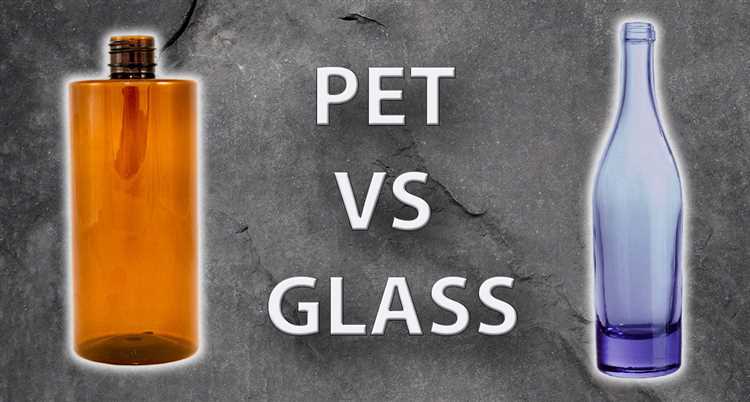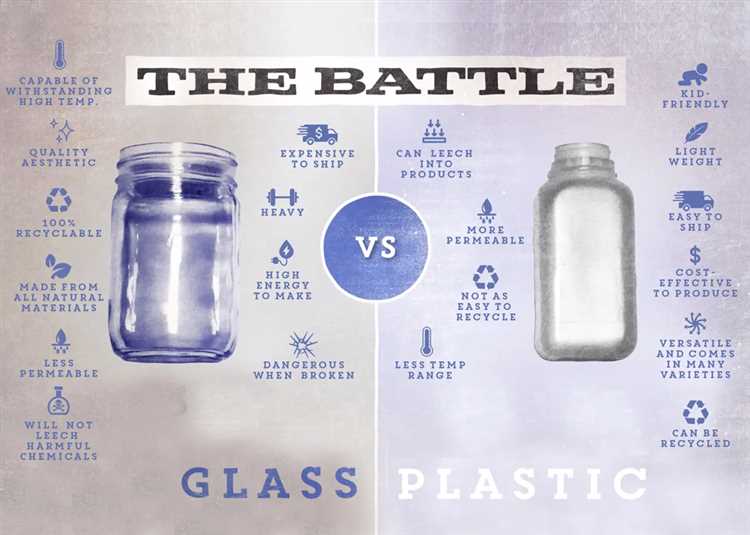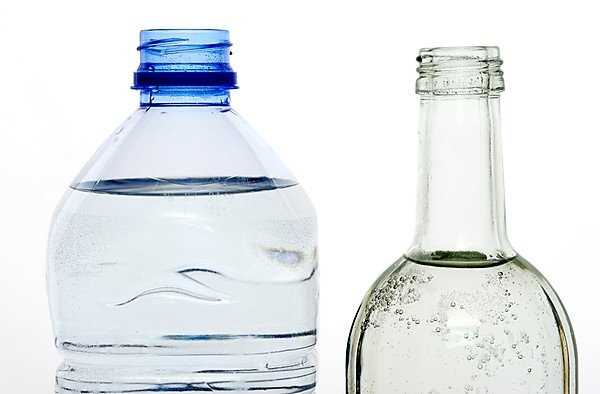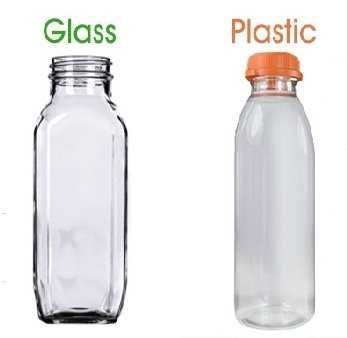
Plastic and glass are two common materials that are used in our everyday lives, but have you ever stopped to consider which one is more harmful?
Plastic is a synthetic material that is derived from petroleum, while glass is a natural material that is made from sand. Both materials have their pros and cons, but when it comes to their impact on the environment and human health, the difference becomes more apparent.
Plastic is known for its convenience and versatility. It is lightweight, durable, and can be molded into various shapes and sizes. However, plastic is not biodegradable and can take hundreds of years to decompose. This means that plastic waste ends up in landfills and oceans, polluting the environment and harming marine life.
Glass, on the other hand, is 100% recyclable and can be recycled endlessly without losing its quality. It does not release harmful chemicals when exposed to heat or sunlight, making it a safer option for food and beverage containers. Glass also has a longer lifespan than plastic, making it a more sustainable choice in the long run.
While plastic is widely used due to its affordability and convenience, the harm it causes to the environment and human health cannot be ignored. Plastic waste has become a global crisis, with millions of tons ending up in oceans each year. The microplastics that are released into the environment can also contaminate our food and water sources, posing a risk to human health.
So, when it comes to the question of which material is more harmful, the answer is clear: plastic. While glass may have its drawbacks, it is a more sustainable and environmentally-friendly option that can help reduce our plastic dependency and protect the planet for future generations.
- The Environmental Impact of Plastic vs. Glass: An In-depth Comparison
- Understanding the Global Plastic Crisis
- The Need for Global Action
- The Hidden Dangers of Plastic Pollution
- Health risks for human
- Solutions to plastic pollution
- Examining the Eco-Friendly Aspects of Glass
- Recyclability
- Environmental Impact
- The Energy Consumption of Plastic Manufacturing
- Conclusion
- The Environmental Cost of Glass Production
- Choosing the Lesser Evil: Making Sustainable Choices
- Reducing Single-Use Consumption
- Education and Awareness
- Q&A:
- Which material, plastic or glass, is more harmful for the environment?
- What are some of the negative effects of using plastic?
- What are the benefits of using glass instead of plastic?
- Is all plastic harmful to the environment?
- What can we do to reduce our use of plastic and glass?
- Why is plastic harmful?
The Environmental Impact of Plastic vs. Glass: An In-depth Comparison
Plastic and glass are two commonly used materials in our daily lives, but have you ever wondered which one has a greater environmental impact?
Plastic, which is derived from fossil fuels, has gained popularity due to its versatility and cheap production costs. However, it poses a significant threat to the environment. Plastic waste takes hundreds of years to decompose, and a large amount ends up in our oceans, endangering marine life and disrupting ecosystems. Additionally, the production of plastic releases greenhouse gases, contributing to climate change.
On the other hand, glass, made from sand, is more environmentally friendly. It is recyclable and can be reused indefinitely without losing its quality. Glass production, however, requires more energy than plastic production, and the transportation of glass containers is heavier and requires more fuel.
When it comes to waste management, plastic poses a bigger challenge. Glass is easier to sort and recycle, whereas plastic recycling rates are significantly lower. In addition, plastic microfibers are released during the washing of synthetic clothing and end up in rivers and seas, further polluting the environment.
Another factor to consider is the health impact. Plastic bottles can leach harmful chemicals into the liquid they contain, potentially posing health risks. Glass, being inert, does not have this issue and is a safer option for packaging food and drinks.
In conclusion, while both plastic and glass have their pros and cons, it is evident that plastic has a greater environmental impact. Its long decomposition time, contribution to pollution and greenhouse gas emissions make it a less sustainable choice compared to glass. Considering the health risks associated with plastic, it is important to reduce our plastic consumption and opt for glass as a more eco-friendly alternative.
Understanding the Global Plastic Crisis

The global plastic crisis refers to the growing issue of plastic pollution and its detrimental impact on the environment and human health around the world. Plastic, being a versatile and durable material, has been widely used in various industries, leading to its excessive production and consumption. However, the improper disposal and inadequate recycling of plastic waste have caused significant harm to ecosystems, wildlife, and even human beings.
One of the key concerns of the global plastic crisis is the enormous amount of plastic waste that ends up in the oceans. It is estimated that around 8 million metric tons of plastic enter the ocean every year, threatening marine life and polluting important habitats such as coral reefs and mangroves. Plastic debris, such as bags, bottles, and microplastics, also pose a significant danger to marine animals, who often mistake them for food and suffer from ingestion or entanglement.
Furthermore, plastic pollution is not only an environmental issue but also a human health concern. Harmful chemicals present in plastic, such as bisphenol A (BPA) and phthalates, can leach into food and drinks, posing risks to human health when consumed. These toxic chemicals have been linked to various health problems, including hormonal disorders, reproductive issues, and certain types of cancer.
The Need for Global Action
Addressing the global plastic crisis requires collaborative efforts and changes at both individual and systemic levels. Governments, businesses, and consumers all play a crucial role in reducing plastic waste and promoting sustainable alternatives.
At the government level, policies and regulations can be implemented to limit the production and use of single-use plastics, promote recycling and waste management infrastructure, and encourage the development of eco-friendly materials. Additionally, international agreements and partnerships can foster cooperation among countries to tackle the issue on a global scale.
Businesses can also contribute by adopting sustainable practices and transitioning to alternative packaging materials. Many companies are now exploring innovative solutions, such as biodegradable plastics or packaging-free options, to reduce their plastic footprint. Consumer demand for eco-friendly products can also drive businesses to prioritize sustainability and offer more environmentally friendly choices.
On an individual level, everyone can play a part in reducing plastic waste by practicing the 5 R’s: refuse, reduce, reuse, recycle, and repeat. This includes refusing single-use plastics, opting for reusable alternatives, actively recycling, and spreading awareness about the importance of responsible consumption.
Conclusion
Understanding the global plastic crisis is essential to address the environmental and health implications caused by plastic pollution. By taking collective action and adopting sustainable practices, we can work towards reducing plastic waste and creating a cleaner and healthier planet for present and future generations.
The Hidden Dangers of Plastic Pollution
Plastic pollution is a global crisis that is causing a wide range of harmful effects on our environment and health. While plastic has many convenient uses in our daily lives, its widespread use and improper disposal have resulted in alarming levels of pollution in our oceans, rivers, and landfills.
One of the greatest dangers of plastic pollution is its impact on marine life. Marine animals often mistake plastic debris for food, leading to ingestion and entanglement. This can have devastating effects on their health and survival. Plastic debris can block their digestive systems, causing starvation, and can also lead to suffocation and suffocation.
Health risks for human
Plastic pollution also poses a significant risk to human health. Microplastics, which are tiny pieces of plastic less than 5 mm in size, have been found in our drinking water, seafood, and even the air we breathe. These microplastics can contain harmful chemicals such as Bisphenol A (BPA) and phthalates, which have been linked to various health issues, including hormonal disruptions, reproductive problems, and cancer.
Plastic pollution also contributes to the global carbon footprint and climate change. The production of plastics requires the use of fossil fuels, a non-renewable resource that contributes to greenhouse gas emissions. In addition, the improper disposal of plastic waste leads to the release of methane, a potent greenhouse gas, from landfills.
Solutions to plastic pollution

To address the hidden dangers of plastic pollution, it is essential to reduce our reliance on single-use plastics and adopt more sustainable alternatives. This can be achieved through measures such as recycling, using reusable shopping bags and water bottles, and supporting policies that promote plastic waste reduction and proper disposal.
Efforts should also be made to improve waste management systems and infrastructure to prevent plastic waste from entering our oceans and waterways. Education and awareness campaigns can play a vital role in informing the public about the impacts of plastic pollution and encouraging responsible consumption and disposal habits.
- Reduce your plastic consumption by opting for products with minimal plastic packaging.
- Recycle plastic waste properly to prevent it from ending up in landfills or water bodies.
- Support local initiatives and organizations working towards plastic pollution reduction and cleanup.
By taking collective action and making conscious choices, we can mitigate the hidden dangers of plastic pollution and protect the health of our environment and ourselves for future generations.
Examining the Eco-Friendly Aspects of Glass
Glass, often praised as a more eco-friendly alternative to plastic, has several characteristics that make it a desirable material from an environmental perspective.
Recyclability
One of the biggest advantages of glass is its recyclability. Unlike plastic, glass can be recycled over and over again without losing its quality. This means that glass has a much higher recycling rate compared to plastic, making it a more sustainable option.
Environmental Impact
Glass production is generally considered to have a lower environmental impact than plastic production. While the process of manufacturing glass does require a significant amount of energy, it typically involves fewer harmful chemicals and pollutants compared to plastic production.
In addition, because glass is made from natural materials such as sand, soda ash, and limestone, it does not contribute to deforestation or require the extraction of non-renewable resources.
Furthermore, when glass does end up in the environment, it poses fewer risks compared to plastic. Unlike plastic, glass is inert and does not release harmful chemicals as it breaks down.
Overall, glass is often seen as a more eco-friendly option due to its recyclability, lower environmental impact during production, and reduced risks when it enters the environment. However, it is important to note that glass still has its own set of sustainability challenges, such as transportation emissions and energy-intensive recycling processes.
The Energy Consumption of Plastic Manufacturing
When comparing plastic and glass, one important factor to consider is the energy consumption associated with the manufacturing process. Plastic manufacturing requires a significant amount of energy, contributing to greenhouse gas emissions and overall carbon footprint.
The production of plastics involves multiple steps, including extraction of raw materials, refining, and manufacturing of the final product. Each of these steps requires energy, primarily sourced from fossil fuels such as coal, oil, and natural gas.
According to research, the primary energy-intensive step in the plastic manufacturing process is polymerization. This is the process where the raw materials are transformed into a polymer, which is the basis of plastic. Polymerization typically requires high temperatures and pressures, increasing the energy demand.
In addition to polymerization, the transportation of raw materials and finished products also contributes to the energy consumption of plastic manufacturing. Raw materials like crude oil and natural gas need to be transported from extraction sites to refining facilities and then to manufacturing plants. Finished plastic products also need to be transported to distribution centers and retail locations.
An analysis of the energy consumption of plastic manufacturing compared to glass production found that on average, plastic manufacturing consumes more energy. The study attributes this higher energy consumption to the energy-intensive polymerization process and the transportation requirements.
It is worth noting that efforts are being made to reduce the energy consumption in plastic manufacturing. These include developing more energy-efficient polymerization processes, using renewable energy sources, and improving transportation logistics to reduce energy-intensive activities.
Conclusion
The energy consumption associated with plastic manufacturing is a significant environmental concern. The process requires a substantial amount of energy, primarily sourced from fossil fuels, contributing to greenhouse gas emissions. While efforts are being made to reduce energy consumption, it is clear that plastic manufacturing has a higher energy demand compared to glass production.
| Plastic Manufacturing | Glass Production |
|---|---|
| High energy consumption | Lower energy consumption |
| Dependent on fossil fuels | Can utilize renewable energy sources |
| Transportation requirements increase energy consumption | Transportation requirements are generally lower |
The Environmental Cost of Glass Production
Glass production, while often lauded for being a recyclable and environmentally-friendly material, still comes with its fair share of negative impacts on the environment.
One major environmental concern associated with glass production is the large amount of energy required. The process of melting raw materials to create glass requires high temperatures, usually fueled by fossil fuels such as natural gas or coal. This leads to the emission of greenhouse gases, contributing to climate change.
Additionally, the extraction of the raw materials needed for glass production can have a detrimental impact on the environment. The mining of sand, which is one of the main raw materials used in glass, can cause habitat destruction and lead to erosion and sedimentation in nearby water bodies. The extraction of other minerals needed for glass production, such as soda ash and limestone, also has its own environmental consequences.
Furthermore, the manufacturing process of glass involves the use of chemicals and additives that can be harmful to both human health and the environment. For example, certain types of glass require the use of heavy metals, such as lead, which can have toxic effects if not properly handled and disposed of.
Lastly, the transportation of glass products can also contribute to environmental pollution. Glass is a heavy and fragile material, which often requires additional packaging and careful handling during transportation. This can result in increased carbon emissions from transportation vehicles and an increased amount of waste generated from packaging materials.
While glass may have certain environmental advantages over plastic, it is important to recognize that its production and use still have a significant impact on the environment. As consumers, it is important to choose products and materials that have the least negative impact on the environment and to properly recycle and dispose of glass to minimize its impact on the planet.
Choosing the Lesser Evil: Making Sustainable Choices

Plastic and glass are two commonly used materials in our daily lives, but both come with their own set of environmental impacts. While glass is generally considered more eco-friendly due to its ability to be recycled indefinitely, plastic also has its own advantages, such as being lightweight and versatile.
When it comes to choosing between the two, it’s important to consider the specific context and use case. For example, if you are looking for packaging materials, glass might be a better option as it is less likely to leach harmful chemicals into the product. On the other hand, if you are looking for a material that is lightweight and easy to transport, plastic might be more suitable.
However, instead of just choosing between plastic and glass, it is also important to explore alternative materials that are even more sustainable. For instance, materials like bamboo, stainless steel, or even compostable bioplastics can offer viable alternatives that have lesser negative impacts on the environment.
Another important factor to consider is the end-of-life disposal of the materials. Glass is typically easier to recycle, as it can be melted down and used to make new glass products. Plastic, on the other hand, often ends up in landfills or as litter, contributing to the global plastic pollution problem. Therefore, proper recycling and waste management systems are crucial in reducing the environmental impact of both materials.
Reducing Single-Use Consumption
One of the most effective ways to make sustainable choices is by reducing our consumption of single-use items altogether. Both plastic and glass can be used in single-use products like bottles, containers, and utensils. By investing in reusable alternatives, such as stainless steel water bottles or glass food containers, we can significantly decrease the amount of waste generated.
Additionally, supporting businesses and brands that prioritize sustainability can also make a difference. Look for companies that use recycled materials, offer refillable options, or have take-back programs for their products.
Education and Awareness
Lastly, education and awareness play a crucial role in making sustainable choices. By informing ourselves about the environmental impact of different materials and the importance of proper waste management, we can make more informed decisions and encourage others to do the same.
In conclusion, when choosing between plastic and glass, it is essential to consider the specific context and use case. However, it is even more important to explore alternative materials and to reduce our consumption of single-use items altogether. By making sustainable choices and advocating for proper waste management, we can contribute to a healthier and more sustainable future.
Q&A:
Which material, plastic or glass, is more harmful for the environment?
Both plastic and glass have negative impacts on the environment, but plastic is generally considered to be more harmful. Plastic is non-biodegradable and takes hundreds of years to break down, while glass is recyclable and can be used over and over again. Plastic also contributes to pollution and is a major source of marine pollution. However, it is important to note that both materials have their own set of environmental challenges.
What are some of the negative effects of using plastic?
Plastic has several negative effects on the environment. It contributes to pollution and is a major source of marine pollution. Plastic waste often ends up in our oceans, harming marine life and ecosystems. Additionally, the production of plastic requires the extraction of fossil fuels, which contributes to climate change. Plastic is also non-biodegradable and takes hundreds of years to break down, leading to long-lasting pollution in our landfills and natural habitats.
What are the benefits of using glass instead of plastic?
Glass has several benefits over plastic. Firstly, glass is recyclable and can be reused many times, while plastic can only be recycled a limited number of times. Glass also has a lower environmental impact as it is made from natural materials and does not require the extraction of fossil fuels. Glass containers are also considered to be safer for storing food and beverages, as they do not leach harmful chemicals into the products they hold. Additionally, glass has a longer lifespan than plastic, reducing the overall amount of waste produced.
Is all plastic harmful to the environment?
While not all plastic is equally harmful, most types of plastic have negative impacts on the environment. The production of plastic requires the extraction of fossil fuels, contributing to climate change and resource depletion. Plastic waste often ends up in our oceans, causing harm to marine life and ecosystems. Plastic is also non-biodegradable and takes hundreds of years to break down, leading to long-lasting pollution in our landfills and natural habitats. Some types of plastic, such as single-use plastics, are particularly harmful due to their short lifespan and high consumption rates.
What can we do to reduce our use of plastic and glass?
There are several steps we can take to reduce our use of plastic and glass. Firstly, we can minimize our consumption of single-use plastics by using reusable alternatives such as cloth bags, water bottles, and food containers. When possible, we should choose products that are packaged in glass instead of plastic. We can also recycle glass and plastic items to reduce our environmental impact. Additionally, supporting policies and initiatives that promote the use of sustainable materials and reduce plastic waste is important in driving change at a larger scale.
Why is plastic harmful?
Plastic is harmful because it is made from fossil fuels, which contributes to climate change. Additionally, plastic takes hundreds of years to decompose and often ends up in landfills or the ocean, causing harm to wildlife and ecosystems.